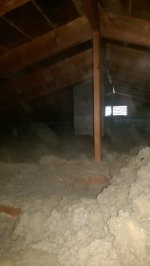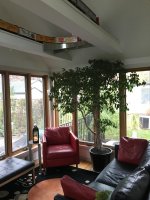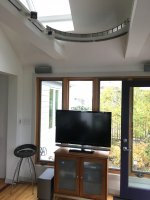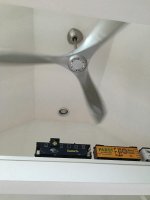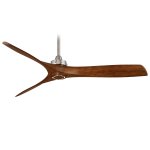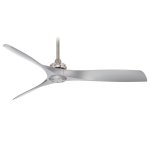Hi guys... I'm trying to help my father out. He isn't sure about removing a wall. But fact is his kitchen is like prison cell sized (ok, it's bigger, but feels like it).
Ideally I'd like to remove the wall and move the ceiling up to the shape of the roof since it has low ceilings everywhere in the house (1950's).
I've attached a picture to show the issue. All that holds up the ceiling is 2x8's, 4x of them. One is directly over the wall I'd like to remove. What I'm not sure about is if the 2x8's (maybe they're 2x6) that run in that insulation that's blown in, all over, may or may not provide support for the outside walls of the house. (keeping them from pulling out)
The close 2x8 you see in the picture is support split over the top of the hallway stud work, so it's distributed over both sides of the hallway. Under it, the ceiling of the downstairs is 2x8's and there's at least one 8x8 post.
When I visit him I get uncomfortable because the house has such low ceilings and small rooms excluding the downstairs living room which was two rooms until a flood when I was a child. My father added several boards to the existing flood when he took out the wall, and it only moved as much as a sawzall blade. But above it is a wall that's the bearing wall between two rooms, that has a 2x8 like in the picture of the attic. I guess the floor is strong enough without anything in there. It's not like my brother and I didn't wrestle, jump, etc, on top of it.
Oh the chimney doesn't do anything, it can be removed at any time.
Well anyway thoughts?
Ideally I'd like to remove the wall and move the ceiling up to the shape of the roof since it has low ceilings everywhere in the house (1950's).
I've attached a picture to show the issue. All that holds up the ceiling is 2x8's, 4x of them. One is directly over the wall I'd like to remove. What I'm not sure about is if the 2x8's (maybe they're 2x6) that run in that insulation that's blown in, all over, may or may not provide support for the outside walls of the house. (keeping them from pulling out)
The close 2x8 you see in the picture is support split over the top of the hallway stud work, so it's distributed over both sides of the hallway. Under it, the ceiling of the downstairs is 2x8's and there's at least one 8x8 post.
When I visit him I get uncomfortable because the house has such low ceilings and small rooms excluding the downstairs living room which was two rooms until a flood when I was a child. My father added several boards to the existing flood when he took out the wall, and it only moved as much as a sawzall blade. But above it is a wall that's the bearing wall between two rooms, that has a 2x8 like in the picture of the attic. I guess the floor is strong enough without anything in there. It's not like my brother and I didn't wrestle, jump, etc, on top of it.
Oh the chimney doesn't do anything, it can be removed at any time.
Well anyway thoughts?

